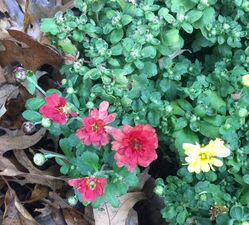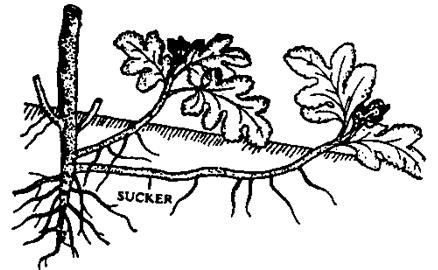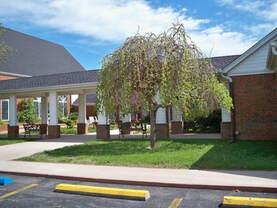|
Ozark Green Thumb BCMG Monthly e-Newsletter |
|
|
 Chrysanthemums, or Chrysanthemum morifolium, are perennial subshrubs of the genus Chrysanthemum in the family Asteraceae.  The plant is a perennial IF it has had adequate time to grow suckers, which is where next year's growth begins. Plants purchased during the fall season have been forced to grow and typically do not have time to establish suckers. For more information about mums and other October garden tips, listen to the October
Master Gardener Mondays ZOOM recording and hear Berni Kurz discuss fall gardening tips. Logon to Buddy Messages for the link, enjoy the talk and prepare your gardens for the winter. Also, click on this link for chrysanthemum history and additional mum tips. https://www.uaex.edu/yard-garden/resource-library/plant-week/garden-mum.aspx
2 Comments
Deadline to register for the Online Master Gardener Basic Training Class is December 6th.
For more information or a registration form, contact your county extension office. In Baxter County, contact Brad Runsick at the University of Arkansas Division of Agriculture Cooperative Extension office at 870-425-2335; or visit at 3 East 9th Street, Mountain Home. This ONLINE class begins January 7 and ends March 31.
By Brad Runsick, University of Arkansas County Extension Office, Agent
All across Arkansas this past season, commercial growers and home gardeners participated in a tomato variety trial. Here in Baxter County, our growers James and Diana Wiegand of Bright House Farms, participated in the project. Both are members of the Baxter County Master Gardeners. The goal of the project was to take three relatively well-known tomato varieties and monitor them through the year for disease incidence as well as their overall yield of marketable fruit and total weight yield. Growers had the option to manage their disease and insect pressure either with conventional or organic pesticides. For the Baxter County project, Bright House Farms opted for the latter. Growers were given 6 plants of each of the following varieties: ‘Cherokee Purple’ (an heirloom variety) ‘Sungold’ (a small, golden cherry tomato) ‘Celebrity’ (a standard size, slicing tomato) Prior to the planting, soil sampling was done to determine if there were any major nutrient needs or soil pH adjustment needed via lime or sulfur. Per label directions, Dipel WP (wettable powder) was used to manage insects and copper fungicide and Serenade RTU were used for disease management. Plants went in the ground on 4/21 and the project was terminated on 8/28 due to slowed production and plant vigor. The project ran into a few pest problems throughout its time. The ‘Cherokee Purples’ really struggled, contracting cucumber mosaic virus (CMV), which is vectored by aphids. The abundance of rain early in the season caused many fruit to split, making them unmarketable, and prone to further disease occurrence. Toward the end of the season, around August, the stinkbug damage became so prevalent that puncture wounds from the feeding resulted in many more fruit that were unmarketable. Here’s a brief summary of the yields that were logged:
As expected, the heirloom struggled when compared to the two hybrids in regards to overall plant vigor and disease occurrence. The nature of the of the Purples to grow large, bumpy tomatoes does lend itself to producing some fruit that generally aren’t marketable due to their appearance and fruit splitting. Bear in mind, many of the unmarketable fruit are fine to eat from a home garden. Defining fruit as marketable or unmarketable is looking at it from a commercially grown, “this tomato has to sell on the shelf” point of view. The two hybrids have some built in resistance to disease, particularly the soil borne Verticillium and Fusarium wilts. So some of their production may be attributed to that resistance. Regardless of all of this, just grow whatever tomato you like the taste of best! Some are easier to care for than others are, but they’ll all produce something to put on your plate. For information on tomato production in the home garden, give us a call sometime at 870-425-2335 or stop by our office at 3 E. 9th St. in Mountain Home. Much thanks to James and Diana Wiegand and Bright House Farms for their participation in this project. Their farm is located near Midway, and they sell at the local farmers’ markets. They did all the work. I just got the plants and wrote this summary! Here’s the November garden checklist!
For more information on any of the above points, contact the University of Arkansas Division of Agriculture Cooperative Extension office at 870-425-2335.  The Baxter County Master Gardeners are a fun group of folks who enjoy sharing their love of gardening with any visitor. At our meetings we have speakers, refreshments, & fun. Come join us! Next Meeting Date: November 14, 2019 from 1:00 - 3:00 pm Meeting Place: The First Presbyterian Church 1106 Spring Street Mountain Home, AR November Speakers: Guest Speaker: Brad Runsick, University of Arkansas, Cooperative Extension Agent-Staff Chair Topic: Wrapping Up Your Garden for Winter Horticulture Table: Jason Chamberlain Topic: How to Prune Grapevines Master Gardeners Monthly Radio Program: Mountain Talk Radio November 20th on 97.1 7:15 a.m. - 8:am. Master Gardener Hosts this month are Tommy Hagan and Ceil Gasiecki Directions: From Mountain Home Take US Hwy. 62B East through Mountain Home until you come to Cardinal Street. Cardinal Street is the intersection just past Harp's Grocery. Turn right onto Cardinal Street and travel South until you come to the first stop sign which should be Spring Street. Turn left onto Spring Street and go down the hill past the bridge and the First Presbyterian Church will be on your right hand side. From Gassville: Take Hwy. 62/412 towards Mountain Home. Once you get to Mountain Home continue on into Mountain Home on US 62B. This will take you through town till you get to Harp's Grocery and you come to Cardinal Street. Cardinal Street is the intersection just past Harp's Grocery. Turn right onto Cardinal Street and travel South until you come to the first stop sign which should be Spring Street. Turn left onto Spring Street and go down the hill past the bridge and the First Presbyterian Church will be on your right hand side. here to edit. |
Archives
April 2022
|
|
